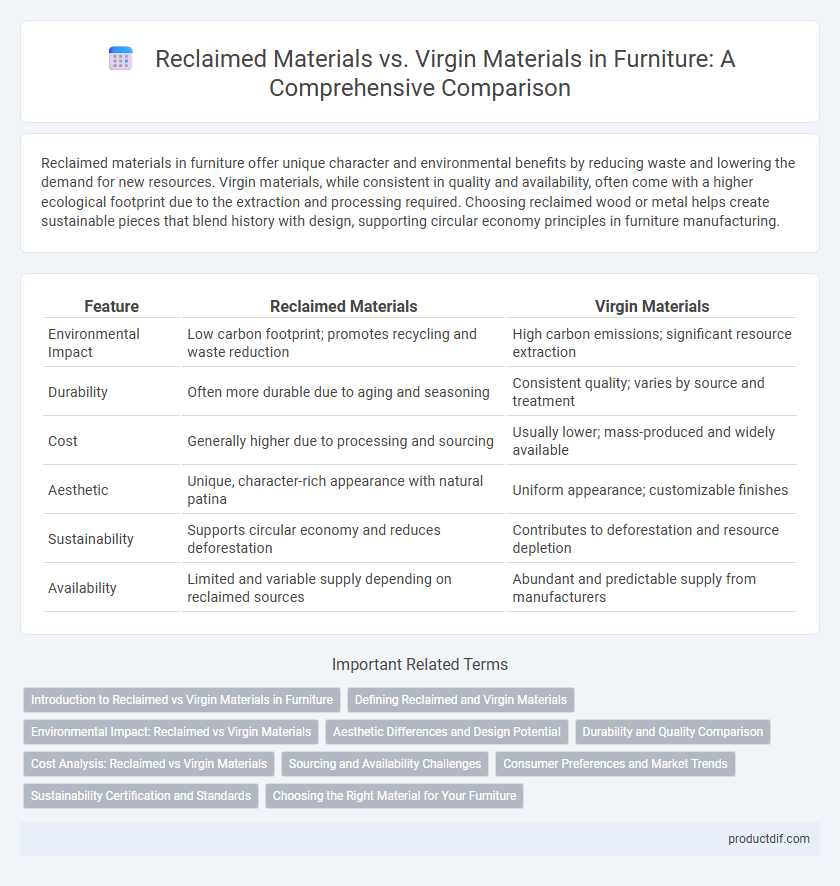Reclaimed materials in furniture offer unique character and environmental benefits by reducing waste and lowering the demand for new resources. Virgin materials, while consistent in quality and availability, often come with a higher ecological footprint due to the extraction and processing required. Choosing reclaimed wood or metal helps create sustainable pieces that blend history with design, supporting circular economy principles in furniture manufacturing.
Table of Comparison
| Feature | Reclaimed Materials | Virgin Materials |
|---|---|---|
| Environmental Impact | Low carbon footprint; promotes recycling and waste reduction | High carbon emissions; significant resource extraction |
| Durability | Often more durable due to aging and seasoning | Consistent quality; varies by source and treatment |
| Cost | Generally higher due to processing and sourcing | Usually lower; mass-produced and widely available |
| Aesthetic | Unique, character-rich appearance with natural patina | Uniform appearance; customizable finishes |
| Sustainability | Supports circular economy and reduces deforestation | Contributes to deforestation and resource depletion |
| Availability | Limited and variable supply depending on reclaimed sources | Abundant and predictable supply from manufacturers |
Introduction to Reclaimed vs Virgin Materials in Furniture
Reclaimed materials in furniture involve using salvaged wood, metal, or fabric from old structures or products, promoting sustainability and unique character. Virgin materials are newly sourced raw materials typically harvested or produced specifically for furniture manufacturing, ensuring consistency and uniform quality. Choosing reclaimed versus virgin materials impacts environmental footprint, cost, and aesthetic appeal in furniture design.
Defining Reclaimed and Virgin Materials
Reclaimed materials in furniture refer to wood, metal, or other components salvaged from old structures, furniture, or industrial byproducts, offering a sustainable alternative by reducing waste and preserving natural resources. Virgin materials are newly sourced raw materials extracted or harvested directly from forests, mines, or plantations without prior use, ensuring consistent quality and uniformity but often with a higher environmental impact. Understanding the distinction between reclaimed and virgin materials is crucial for eco-conscious furniture design and manufacturing decisions.
Environmental Impact: Reclaimed vs Virgin Materials
Reclaimed materials significantly reduce environmental impact by minimizing waste and lowering demand for raw resource extraction, which conserves forests and reduces landfill use. Virgin materials require extensive energy consumption and contribute to higher carbon emissions throughout mining, processing, and manufacturing stages. Furniture made from reclaimed wood or metal supports sustainable practices by promoting circular economy principles and reducing overall ecological footprint.
Aesthetic Differences and Design Potential
Reclaimed materials offer unique textures, weathered finishes, and history-rich patinas that enhance furniture with character and a one-of-a-kind aesthetic, while virgin materials provide uniformity, consistent color, and smooth surfaces ideal for contemporary, minimalist designs. The design potential of reclaimed wood allows artisans to create rustic, vintage, and eco-conscious pieces that highlight natural imperfections, whereas virgin materials support precision craftsmanship and modern styles requiring flawless, clean lines. Selecting between reclaimed and virgin materials influences the visual narrative and sustainability story embedded in furniture design, catering to distinct consumer preferences and interior themes.
Durability and Quality Comparison
Reclaimed materials in furniture often exhibit enhanced durability due to natural aging and weathering, resulting in stronger and more stable wood compared to virgin materials. Virgin materials, while consistently uniform, may lack the unique character and resilience found in reclaimed wood, which often undergoes less processing and retains its original density. Quality in reclaimed furniture is frequently superior when craftsmanship emphasizes preservation, creating distinctive pieces with lasting structural integrity.
Cost Analysis: Reclaimed vs Virgin Materials
Reclaimed materials typically offer a lower cost basis due to reduced raw material expenses and decreased processing requirements compared to virgin materials, which involve higher extraction and manufacturing costs. While reclaimed wood and metals may require additional labor for quality checks and finishing, these expenses are often offset by savings in material procurement. Choosing reclaimed materials can lead to significant budget efficiencies in furniture production without compromising durability or aesthetic appeal.
Sourcing and Availability Challenges
Reclaimed materials in furniture sourcing demand rigorous vetting to ensure structural integrity and aesthetic quality, often resulting in limited and inconsistent availability compared to virgin materials sourced from controlled forestry and manufacturing processes. Virgin materials typically offer reliable supply chains with predictable volume and dimensions, while reclaimed items depend on variable salvage systems, making large-scale production challenging. The escalated demand for sustainable furnishings heightens competition for quality reclaimed wood, further complicating procurement efforts and driving up costs.
Consumer Preferences and Market Trends
Consumer preferences in furniture increasingly favor reclaimed materials due to their environmental benefits and unique aesthetic appeal, boosting demand for sustainable and eco-friendly products. Market trends indicate a significant rise in sales of furniture made from reclaimed wood and recycled metals, reflecting growing awareness of resource conservation and waste reduction. Virgin materials, while still prevalent for their consistency and lower cost, face declining popularity as consumers prioritize ethical sourcing and carbon footprint reduction in their purchasing decisions.
Sustainability Certification and Standards
Reclaimed materials in furniture manufacturing often meet rigorous sustainability certifications such as FSC Recycled or Cradle to Cradle, highlighting their reduced environmental impact compared to virgin materials sourced directly from forests with FSC or PEFC certification. Using certified reclaimed wood lessens deforestation and reduces carbon footprints by minimizing the need for new raw material extraction. Sustainable standards ensure transparency and traceability, verifying that reclaimed materials uphold environmental and social responsibility throughout the supply chain.
Choosing the Right Material for Your Furniture
Reclaimed materials offer unique character and environmental benefits by reducing waste and resource consumption, making them a sustainable choice for eco-conscious furniture buyers. Virgin materials provide consistency, durability, and design flexibility, often preferred for high-end or contemporary pieces demanding precise specifications. Evaluating your furniture's intended use, budget, and environmental priorities will guide selecting between reclaimed and virgin materials to balance aesthetics, sustainability, and performance.
Reclaimed materials vs virgin materials Infographic

 productdif.com
productdif.com